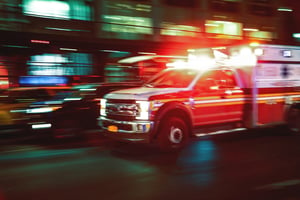 No matter what time of the year you’re driving, you’ll likely come upon a vehicle pulled over on the shoulder or moving slowly. It could be a snowplow, tow truck, police car, or a stranded, broken-down car. No matter what the situation is, do you know what to do? And what about when you’re driving and hear sirens but don’t know which direction they’re coming from?
No matter what time of the year you’re driving, you’ll likely come upon a vehicle pulled over on the shoulder or moving slowly. It could be a snowplow, tow truck, police car, or a stranded, broken-down car. No matter what the situation is, do you know what to do? And what about when you’re driving and hear sirens but don’t know which direction they’re coming from?
Here are some driving tips for you and your family.
Snowplows
During the winter months, snowplow drivers are busy keeping our roads in good driving condition. If it weren’t for them, there probably would be times we’d be unable to drive. If you come upon a snowplow, here are some things to remember:
1. Keep your cool.
Let’s face it: the last thing anybody wants is to get stuck behind a plow that’s shooting snow into the air and dropping salt. However, it’s best to keep your composure. Aggressively trying to get by the plow could have dangerous and deadly consequences.
2. Don’t tailgate.
When driving in poor weather, tailgating is the last thing you should do. Tailgating a snowplow will do you no good. More than likely, the driver can’t see you. And your aggressive behavior isn’t going to get the plow to move out of your way. It’s more likely that your car will get damaged.
3. Pass with caution.
If there’s an opportunity to pass, do it cautiously. With all the equipment attached to the plow, the driver’s primary focus is on what’s in front of them, and it’s likely the driver won’t see you. Lastly, you should never pass in a no-passing zone, no matter the time of the year.
Tow trucks or maintenance equipment
Tow truck operators are out and about in all kinds of weather conditions. In addition, based on the situation, they’re likely not just sitting on the side of the road. They may block one lane as they try to winch a car out of a ditch. Here are some things you can do to help:
1. Change lanes.
If you’re on a four-lane roadway and come upon a tow truck with flashing lights, change lanes. This will give the tow truck operators more space to do their jobs and keep them safe.
2. Slow down.
If you’re not on a four-lane road or unable to change lanes, reduce your speed significantly. If you’re in a state with “Mover Over or Slow Down” laws, be sure you’re familiar with them. Some states recommend driving 10-20 mph below the posted speed limit in these situations.
3. Don’t drive distracted.
Driving distracted is foolish and dangerous. It’s a good idea to stay distraction-free, especially if you’re experiencing traffic congestion or approaching emergency or maintenance vehicles.
Emergency vehicles
When you’re driving and you hear sirens, it’s crucial to figure out where it’s coming from and then make appropriate decisions. Unfortunately, for emergency crews, time is of the essence.
Here are some things you can do to help them out and possibly save someone’s life:
1. Cover the brake.
By the number of people I see running red lights, it seems like many have forgotten a basic rule from driver’s education which is to cover the brake as you near an intersection. The same holds true for emergency vehicles. If you can hear them but can’t see them, it’s a good idea to cover your brake until you know where they are.
2. It’s best to pull over.
It may seem like a good idea to turn the corner to get out of their way. However, if they follow you around the corner, that maneuver doesn’t work. It’s always best to pull over to the right side of the road and stop. If you can’t pull over and stop altogether, slow down.
3. Don’t reach for your phone.
If you’re passing an accident scene, don’t pick up your phone to take a picture. Not only can the distraction cause an accident, but it’s also simply disrespectful to the injured party.
Do you have any suggestions or information you’d like to share? I’d love to hear from you. Please share them in the box below.





